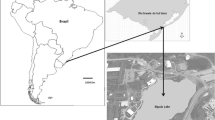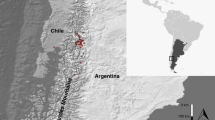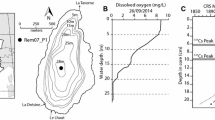Abstract
The water-level regime is a major determinant of the community structure in river-floodplain systems. Chironomidae is a highly diverse insect family that plays a key role in the trophic structure and functioning of floodplain systems. However, we know little about how water-level oscillations affect the chironomid structure. Using a 9-year database, we investigated how the richness, density, and temporal β-diversity of chironomid larvae are affected by water-level oscillations and environmental variables in a tropical lake. We tested the hypotheses that (i) in high-water-level periods, the Chironomidae community is more similar (homogeneous) among sites within the lake; (ii) in low-water-level periods, the Chironomidae community is more variable, and that this is likely because (iii) the importance of environmental filtering is stronger in low-water-level periods than in high-water-level periods. We found a hump-shaped relationship between chironomid richness and density with water level, and a monotonic negative relationship between chironomid β-diversity and water level over the years. Chironomidae composition was structured by water-level oscillations during the high-water-level period, whereas during the low-water-level period, environmental filtering was the most important structuring factor. In addition, Chironomidae density and richness decreased in high- and low-water-level periods compared to intermediate-water-level periods, and temporal Chironomidae β-diversity increased in low-water-level periods and decreased in high-water-level periods. Our findings are important considering that extreme climatic events tend to increase in frequency and intensity in the future, which may increase the frequency of extreme low- and high-water-level periods in floodplain systems.





Similar content being viewed by others
References
Agostinho AA, Gomes LC, Thomaz SM, Hahn NS (2004) The Upper Paraná River and its floodplain: Main characteristics and perspectives for management and conservation. In: Thomaz SM, Agostinho AA, Hahn NS (eds) The upper Paraná river and its floodplain: physical aspects, ecology and conservation. Backhuys Publishers, Leiden, The Netherlands, pp. 381–393
Anderson MJ, Crist TO, Chase JM, Vellend M, Inouye BD, Freestone AL, Sanders NJ, Cornell HV, Comita LS, Davies KF, Harrison SP, Kraft NJB, Stegen JC, Swenson NG (2011) Navigating the multiple meanings of β diversity: a roadmap for the practicing ecologist. Ecol Lett 14:19–28
Aspin TWH, Matthews TJ, Khamis K, Milner AM, Wang Z, O’Callaghan MJ, Ledger ME (2018) Drought intensification drives turnover of structure and function in stream invertebrate communities. Ecography 41:1992–2004
Bertoncin APS, Pinha GD, Baumgartner MT, Mormul RP (2019) Extreme drought events can promote homogenization of benthic macroinvertebrate assemblages in a floodplain pond in Brazil. Hydrobiologia 826:379–393
Bogan MT, Boersma KS, Lytle DA (2013) Flow intermittency alters longitudinal patterns of invertebrate diversity and assemblage composition in an arid-land stream network. Freshwater Biol 58:1016–1028
Bovo-Scomparin VM, Train S (2008) Long-term variability of the phytoplankton community in an isolated floodplain lake of the Ivinhema River State Park, Brazil. Hydrobiologia 610:331–344
Bozelli RL, Thomaz SM, Padial AA, Lopes PM, Bini LM (2015) Floods decrease zooplankton beta diversity and environmental heterogeneity in an Amazonian floodplain system. Hydrobiologia 753:233–241
Bray JR, Curtis JT (1957) An ordination of upland forest communities of southern Wisconsin. Ecol Monogr 27:325–349
Buss DF, Borges EL (2008) Application of Rapid Bioassessment Protocols (RBP) for Benthic Macroinvertebrates in Brazil: Comparison between Sampling Techniques and Mesh Sizes. Neotrop Entomol 37:288–295
Campos R, Conceição EO, Martens K, Higuti J (2019) Extreme drought periods can change spatial effects on periphytic ostracod metacommunities in river-floodplain ecosystems. Hydrobiologia 828:369–381
Cañedo-Argüelles M, Bogan MT, Lytle DA, Prat N (2016) Are Chironomidae (Diptera) good indicators of water scarcity? Dryland streams as a case study. Ecol Indic 71:155–162
Conceição EO, Higuti J, Campos R, Martens K (2018) Effects of flood pulses on persistence and variability of pleuston communities in a tropical floodplain lakes. Hydrobiologia 807:175–188
Dai B, Jiang Z, Wang C, Matsuzaki S-IS, Zhou L (2020) Abundance-based dissimilarity measurements reveal higher heterogeneity of fish communities in the lotic habitats of the Yangtze-Caizi transitional floodplain. Ecol Indic 112:106122
Epler JH (1995) Identification manual for the larval Chironomidae (Diptera) of Florida, Revised. Florida, Florida Department of Environmental Protection
Filazzola A, Matter SF, MacIvor JS (2021) The direct and indirect effects of extreme climate events on insects. Sci Total Environ. https://doi.org/10.1016/j.scitotenv.2021.145161
Frouz J, Matena J, Ali A (2003) Survival strategies of chironomids (Diptera: Chironomidae) living in temporary habitats: a review. Eur J Entomol 100:459–465
Gandouin E, Ponel P, Franquet E, Vliet-Lanoë BV, Andrieu-Ponel V, Keen DH, Brulhet J, Brocandel M (2007) Chironomid responses (Insect:Diptera) to Younger Dryas and Holocene environmental changes in a river floodplain from northern France (St-Momelin, St-Omer basin). Holocene 17:331–347
Gower JC (1966) Some distance properties of latent root and vector methods used in multivariate analysis. Biometrika 53:325–328
Hakanson L, Jansson M (1983) Principles of lake sedimentology. Springer-Verlag, Berlin
Heino J, Virkkala R, Toivonen H (2009) Climate change and freshwater biodiversity: detected patterns, future trends and adaptations in northern regions. Biol Rev 84:39–54
Henriques-Oliveira AL, Nessimian JL, Dorvillé LFM (2003) Feeding habitats of Chironomidae larvae (Insecta: Diptera) from a stream in the Floresta da Tijuca, Rio de Janeiro, Brazil. Braz J Biol 63:269–281
Hothorn T, Bretz F, Westfall P (2014) Package ‘multcomp’. Simultaneous inference in general parametric models. https://cran.r-project.org/web/packages/multcomp/vignettes/generalsiminf.pdf
Intergovernmental Panel on Climate Change - IPCC (2014) Synthesis Report. Contribution of Working Groups I, II and III to the Fifth Assessment Report of the intergovernmental Panel on Climate Change [Core Writing Team, R.K Pachauri and L.A. Meyer (eds.)]. IPCC, Geneva, Switzerland, 151 pp
Jorcin A, Nogueira MG (2008) Benthic macroinvertebrates in the Paranapanema reservoir cascade (southeast Brazil). Braz J Biol 68:1013–1024
Junk WJ, Bayley PB, Sparks RE (1989) The flood pulse concept in river-floodplain systems. Can Spec Publ Fish Aquat Sci 106:110–127
Legendre P, De Cáceres MD (2013) Beta diversity as the variance of community data: dissimilarity coefficients and partitioning. Ecol Lett 16:951–963
Legendre P, Legendre L (1998) Numerical Ecology: Developments in Environmental Modelling (20), 2nd edn. Elsevier, Amsterdam
Leibold MA, Holyoak M, Mouquet N, Amarasekare P, Chase JM, Hoopes MF, Holt RD, Shurin JB, Law R, Tilman D, Loreau M, Gonzalez A (2004) The metacommunity concept: a framework for multi-scale community ecology. Ecol Lett 7:601–613
Leigh C, Aspin TWH, Matthews TJ, Rolls RJ, Ledger ME (2019) Droughts alters the functional stability of stream invertebrate communities through time. J Biogeogr 46:1988–2000
Lento J, Dillon PJ, Somers KM (2012) Evaluating long-term trends in littoral benthic macroinvertebrate communities of lakes recovering from acid deposition. Environ Monit Assess 184:7175–7187
Luz-Agostinho KDG, Agostinho AA, Gomes LC, Júlio HF Jr (2008) Influence of flood pulses on diet composition and trophic relationships among piscivorous fish in the upper Paraná River floodplain. Hydrobiologia 607:187–198
Mermillod-Blondin F, Marmonier P, Tenaille M, Lemoine DG, Lafont M, Vorste RV, Simon L, Volatier L (2020) Bottom-up processes control benthic macroinvertebrate communities and food web structure of fishless artificial wetlands. Aquat Ecol 54:575–589
Moi DA, Ernandes-Silva J, Baumgartner MT, Mormul RP (2020) The effects of river-level oscillations on the macroinvertebrate community in a river–floodplain system. Limnology 21:219–232
Moi DA, Romero GQ, Antiqueira PAP, Mormul RP, Teixeira de Mello F, Bonecker C (2021) Multitrophic richness enhances ecosystem multifunctionality of tropical shallow lakes. Funct Ecol. https://doi.org/10.1111/1365-2435.13758
Montanholi-Martins MC, Takeda AM (2001) Spatial and temporal variations of oligochaetes of the Ivinhema River and Patos Lake in the Upper Paraná River Basin, Brazil. Hydrobiologia 463:197–205
Mormul RP, Thomaz SM, Takeda AM, Behrend RD (2011) Structural complexity and distance from source habitat determine invertebrate abundance and diversity. Biotropica 43(6):738–745
Mormul RP, Thomaz SM, Agostinho AA, Bonecker CC, Mazzeo N (2012) Migratory benthic fishes may induce regime shifts in a tropical floodplain pond. Freshwater Biol 57:1592–1602
Neiff JJ (1990) Ideas para la interpretación ecológica del Paraná. Interciencia 15:424–441
Nicacio G, Juen L (2018) Relative roles of environmental and spatial constraints in assemblages of Chironomidae (Diptera) in Amazonian floodplain streams. Hydrobiologia 820:201–213
Oksanen FJ, Blanchet G, Friendly M, Kindt R, Legendre P, McGlinn D, Minchin PR, O’Hara RB, Simpson GL, Solymos P, Tevens MHH, Szoecs E, Wagner H (2017) Vegan: community ecology package. R package version 2:4–4. https://CRAN.R-project.org/package=vegan
Özkan N, Moubayed-Breil J, Çamur-Elipek B (2010) Ecological Analysis of Chironomid Larvae (Diptera, Chironomidae) in Ergene River Basin (Turkish Thrace). Turkish J Fish Aquat Sci 10:93–99
Petsch DK, Bertoncin APS, Gentilin-Avanci C, Favro A, González-Trujillo JD, Pinha GD (2020) High water flow velocity reduces beta diversity and leads to a distinct composition of Oligochaeta in neotropical lotic ecosystems. Limnology 21:297–304
Petsch DK, Cottenie K, Padial AA, Dias JD, Bonecker CC, Thomaz SM, Melo AS (2021) Floods homogenize aquatic communities across time but not across space in a Neotropical floodplain. Aquat Sci 83:19
Pozzobom UM, Heino J, Brito MAS, Landeiro VL (2020) Untangling the determinants of macrophyte beta diversity in tropical floodplain lakes: insights from ecological uniqueness and species contributions. Aquat Sci 82:53
R Core Team (2017) R: a language and environment for statistical computing. R Foundation for Statistical Computing, Vienna, Austria. URL https://www.R-project.org/
Rao C (1964) The Use and Interpretation of Principal Component Analysis in Applied Research. Sankhyā Ser A 26:329–358
Roberto MC, Santana NF, Thomaz SM (2009) Limnology in the Upper Paraná River floodplain: large-scale spatial and temporal patterns, and the influence of reservoirs. Braz J Biol 69:717–725
Robinson CT, Tockner K, Burgherr P (2002) Seasonal patterns in macroinvertebrate drift and seston transport in streams of an alpine glacial flood plain. Freshwater Biol 47:985–993
Rosenberg DM, Resh VH (1993) Introduction to freshwater biomonitoring and benthic macroinvertebrates. In: Rosenberg DM, Resh VH (eds) Freshwater Biomonitoring and Benthic Macroinvertebrates. New York, Chapman and Hall, pp 1–9
Rosin GC, Takeda AM (2007) Larvas de Chironomidae (Diptera) da planície de inundação do alto rio Paraná: distribuição e composição em diferentes ambientes e períodos hidrológicos. Acta Sci Biol Sci 29:57–63
Rosin GC, Oliveira-Mangarotti DP, Takeda AM, Butakka CMM (2009) Consequences of dam construction upstream of the Upper Paraná River floodplain (Brazil): a temporal analysis of the Chironomidae community over an eight-year period. Braz J Biol 69:591–608
Shimabukuro EM, Henry R (2011) Controlling factors of benthic macroinvertebrates distribution in a small tropical pond, lateral to the Paranapanema River (São Paulo, Brazil). Acta Limnol Bras 23(2):154–163
Souza AHFF, Abílio FJP, Ribeiro LL (2008) Colonização e Sucessão Ecológica do Zoobentos em Substratos Artificiais no Açude Jatobá I, Patos – PB, Brasil. Rev Biol Ciênc Terra 8:125–144
Souza Filho EE, Stevaux JC (1997) Domínio Físico. In: Vazzoler AEA, Agostinho AA, Hahn NS (eds) A planície de inundação do alto rio Paraná: Aspectos físicos, biológicos e socioeconômicos. Maringá, EDUEM, pp 3–46
Souza Filho EE, Stevaux JC (2004) Geology and geomorphology of the Baía-Curutuba-Ivinhema river complex. In: Thomaz SM, Agostinho AA, Hahn NS (eds) The Upper Paraná River and its floodplain: Physical Aspects, Ecology and Conservation. Leiden, Backhuys Publishers, pp 1–29
Thomaz SM, Pagioro TA, Bini LM, Roberto MC, Rocha RRA (2004) Limnology of the Upper Paraná Floodplain hábitats: Patterns of Spatio-temporal Variations and Influence of the Water Levels. In: Agostinho AA, Rodrigues L, Gomes LC, Thomaz SM, Miranda LE (eds) Structure and functioning of the Paraná river and its floodplain. Maringá, EDUEM, pp 37–42
Thomaz SM, Bini LM, Bozelli RL (2007) Floods increase similarity among aquatic habitats in river-floodplain systems. Hydrobiologia 579:1–13
Trivinho-Strixino S (2011) Larvas de Chironomidae: Guia de identificação. Gráfica UFScar: São Carlos
Trivinho-Strixino S, Strixino G (1995) Larvas de Chironomidae (Diptera) do Estado de São Paulo. Guia de identificação e diagnose dos gêneros. PPG-ERN UFSCar: São Carlos
Wentworth CK (1922) A scale of grade and class terms for clastic sediments. J Geol 30:377–392
Whittaker RH (1962) Classification of natural communities. Bot Rev 28:1–239
Wood S (2017) Generalized Additive Models. Chapman and Hall/CRC, New York. https://doi.org/10.1201/9781315370279
Woodward G, Perkins DM, Brown LE (2010) Climate change and freshwater ecosystems: impacts across multiple levels of organization. Phil Trans R Soc B 365:2093–2106
Zerlin RA, Henry R (2014) Does water level affect benthic macro-invertebrates of a marginal lake in a tropical river-reservoir transition zone? Braz J Biol 74(2):408–419
Acknowledgements
We acknowledge the handling Editor Dr. Jamie Kneitel and two anonymous reviewers for their constructive comments, which improved the first two versions of this manuscript. SPJ thanks to Coordination for the Improvement of Higher Education Personnel (CAPES) for his Master’s scholarship. DAM thanks to Brazilian National Council for Scientific and Technological Development (CNPq) for his PhD scholarship. RPM thanks to CNPq for the constant funding and productivity research grant.
Author information
Authors and Affiliations
Corresponding author
Ethics declarations
Conflict of interests
All authors declare no conflicts of interest.
Additional information
Handling Editor: Jamie Kneitel.
Publisher's Note
Springer Nature remains neutral with regard to jurisdictional claims in published maps and institutional affiliations.
Supplementary Information
Below is the link to the electronic supplementary material.
Rights and permissions
About this article
Cite this article
Mormul, R.P., Moi, D.A., Pressinatte-Júnior, S. et al. Temporal dynamics of Chironomid (Diptera) diversity under flood–drought pulses in a shallow tropical floodplain lake. Limnology 23, 37–48 (2022). https://doi.org/10.1007/s10201-021-00668-w
Received:
Accepted:
Published:
Issue Date:
DOI: https://doi.org/10.1007/s10201-021-00668-w




